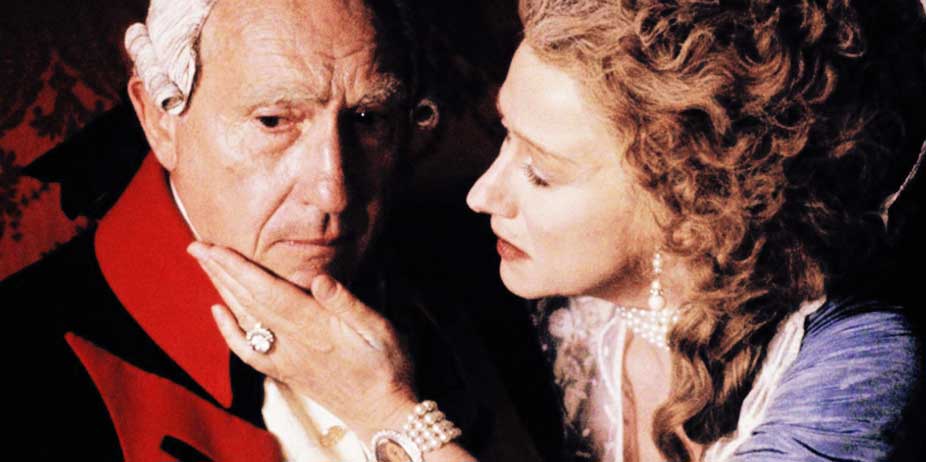The Madness of King George (1994)
This film attempts to be both a light-hearted glimpse of a serious subject scathed in satire, and a serious study of Georgian England and its petty government policies. But what it manages to be instead is a sometimes painful cross between Oscar Wilde and King Lear. From a historical standpoint, the film stays relatively close to the facts until the final conclusion. The opening act gives us a memorable glimpse of the irony of the life of royals behind the curtain. A harried-looking attendant spitting on the crown jewels and polishing it on his sleeve. Soldiers tramping past one of the King's many children, only to have a howl go up when they knock her wooden horse aside. A bored-looking Prince of Wales (Rupert Everett) with an inept hairdo, paunchy stomach, and yawn that swallows his entire face. The royals get into line, along with several dull-looking chancellors, and argue all the way to Parliament.
Irony at its best, and this merely sets the stage for the hour and a half film that will follow, exploring the ups and downs of palace life. King George III (Nigel Hawthorne) has just lost the colonies in the Revolutionary War, and the "United States" are now a thorn in his side. He loathes that they lost that great, untamed land to the Americans and forbids the subject to be spoken of. His eldest son and heir, the Prince of Wales, is yet another prick to his tempter, for he desires the "pudgy boy" to be married. Despite this, he and his wife (Helen Mirren) are happy... albeit concerned with some of his violent stomach aches. Increasingly, good old George begins to act more and more peculiar... he looses his temper easily, is prone to fits of lunacy, and starts a brawl with his own son. Realistically here is where the comedy ends and the satire and a many uncomfortable moments begin, as he behaves strangely in mixed company.
Something isn't quite right. Suddenly he's flirting with the Queen's Lady-in-Waiting and popping up innuendos. He has fits of hallucinations and endangers the children. In all appearances he's gone mad and the doctors can do little to help. When the Prince learns of this, he immediately begins scheming to see how he might claim the throne of England. He separates the Queen and King, but she has an ally in Lady Pembroke, and George has a faithful, concerned follower in his latest guard, Greville. They're going to need all the help they can find if they're to convince Parliament that George III is not mad, but merely ill. And to do that, they must find a cure for this strange ailment before tragedy strikes the halls of Winsor. It's a battle between the court and royals, a struggle amongst the commoners and aristocrats alike. It's a sometimes humorous but more often than not painful look at the King whose tyranny drove the colonists to revolt. It's The Madness of King George.
If there is anything memorable about the film, it's the performances. Nigel Hawthorne, having sharpened his character of King George by years on the stage, is a sometimes sporadic, sometimes lovable, and always pitiable royal, whether he be in a fit of madness running through the countryside cursing the Colonies, in a moment of sanity commanding to the Prince, 'Do not be fat, sir! Fight it, what!' or sobbing over some cruel torture devised by his doctors to draw the fever from his head. He really does give a heartbreaking performance, heading up an excellent cast. The costuming and sets are delightfully authentic but at times almost unbearably silly. Rupert Everett dons the most horrendous wig of the entire cast, a frizzy, red-tinted concoction that along with his paunchy stomach give him an almost idiotic presence on-screen. But despite the performances and wit, the film is a disappointment, made so by sexual innuendo, a seemingly never-ending obsession with the king's bodily fluids, and the cruel practices of doctors who have no idea how to treat this 'madness.' Some of the "antidotes" they attempted are truly heartbreaking and shatter the king's physical and mental capabilities. It is only with a clergyman-turned-physician's cruel but less malicious approach that George begin to improve.
While there is no actual sexual content on-screen, the film delights in alluding to things. There is talk that the king would have been more sane if he'd kept to family tradition and had several mistresses. In moments of insanity he remarks on, touches, and even once kisses violently Lady Pembroke, who isn't herself the most innocent woman in court. Although married (her husband is never seen), she flirts with the king's soldier in return of a favor for the Queen. In one scene she comes on to him in the palace corridor. What happens we don't know, although at least kissing and grouping were involved. There's immodesty in dress; the men wear tight breeches and sometimes wander around in their nightshirts, showing a lot of leg. The women's gowns are all low. The Prince is seen with a woman in bed, but all they do is kiss. (We learn later that they were married; although the film leads us to believe for a time that she was merely a mistress.) There's some violent content in the restraint of the King and profanity. One abuse of "Jesus" makes up the worst of deity-related curses but there's also a half-wit, half-offensive remark made in church. "Well?" someone asks the councilor, and he fires back, "I'm praying, g--d--it!"
The beginning was promising. The early stages were amusing. But by the time everyone in the castle was remarking on the color of the King's urine, I was getting annoyed. And by the end, I was grateful for the closing credits.

